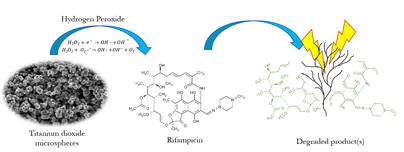Synthesis of spherical titanium dioxide microspheres to degrade rifampicin
2021 #RSCPoster Twitter Conference, 2 March 2021 - 3 March 2021
Paul. K. Kimani
`Gifu University, Japan
[email protected]
ECG Bulletin July 2021
Paul. K. Kimani
`Gifu University, Japan
[email protected]
ECG Bulletin July 2021
Pharmaceutical and personal care products (PPCPs) are an emerging group of contaminants of increasing environmental concern. They are mostly synthetic organic chemicals used to treat various animal and human diseases. Extensively and widely used, they are vital to economies, but end up accumulating in ecosystems via food webs where they pose health-related threats as they are naturally bioactive and are linked to increased cases of ecotoxicity and antimicrobial resistance.
PPCPs find their way into the environment through direct or indirect human excretion such as sweat, urine and faeces that end up in wastewater due to incomplete removal. Recent studies have shown an increased occurrence of antibiotics in water systems, and thus rising demand for mitigation. Various methods have been utilised to remove these pollutants such as coagulation, flocculation and ion exchange, which are, at times, costly. While processes such as membrane bioreactors (MBR) and enzyme-based biocatalysts are still under development, degradation via metal oxides remains cost-effective, efficient and more environmentally friendly.
PPCPs find their way into the environment through direct or indirect human excretion such as sweat, urine and faeces that end up in wastewater due to incomplete removal. Recent studies have shown an increased occurrence of antibiotics in water systems, and thus rising demand for mitigation. Various methods have been utilised to remove these pollutants such as coagulation, flocculation and ion exchange, which are, at times, costly. While processes such as membrane bioreactors (MBR) and enzyme-based biocatalysts are still under development, degradation via metal oxides remains cost-effective, efficient and more environmentally friendly.
|
Rifampicin is one PPCP that has been widely detected in the environment. A semisynthetic broad-spectrum antibiotic produced from Streptomyces mediterranei, it produces activity against forms of mycobacteria. It inhibits DNA-dependent RNA polymerase activity by forming a stable complex with the enzyme. 30% is usually excreted in its active form.
|
Titanium dioxide, TiO2, microspheres were selected and synthesised via a sol-gel process. An aqueous solution of titanium tetrachloride, TiCl4, was reacted with a 1.5 M solution of urea, forming titanium dioxide microspheres. These were characterised via Fourier Transform Infrared Spectroscopy (FT-IR), Differential Scanning Calorimetry (DSC), Thermal Gravimetric Analysis (TGA), Scanning Electron Microscopy (SEM) fitted with an Energy Dispersive X-ray spectrometer (EDS), and X-ray diffraction (XRD). Characterisation showed spherical anatase TiO2 microspheres with sizes ranging from 200–2000 nm.
Comparative degradation studies were performed using the microspheres in the absence or presence of hydrogen peroxide (H2O2) and at different pHs to determine optimum degradation conditions. An aqueous solution of 50 µM rifampicin was prepared from which 3 mL were mixed with 10 mg of microspheres and 1 mL of hydrogen peroxide for the degradation, which was studied at 2 min intervals using a Shimadzu 1800 Ultraviolet-visual (UV-vis) spectrophotometer in the range 300–800 nm. Longer extraction times were required to degrade rifampicin when either H2O2 or TiO2 were used independently, compared to 120 minutes required when used together.
This shows the importance of TiO2 in the generation of radicals that assist in the degradation process. This rate of oxidation was further improved by adjusting the pH to 3 or pH 12 with the highest percentage removal (63.8%) at pH 12. The degradation follows a first-order mechanism with the rate higher in acidic media as compared to neutral or basic media.
Comparative degradation studies were performed using the microspheres in the absence or presence of hydrogen peroxide (H2O2) and at different pHs to determine optimum degradation conditions. An aqueous solution of 50 µM rifampicin was prepared from which 3 mL were mixed with 10 mg of microspheres and 1 mL of hydrogen peroxide for the degradation, which was studied at 2 min intervals using a Shimadzu 1800 Ultraviolet-visual (UV-vis) spectrophotometer in the range 300–800 nm. Longer extraction times were required to degrade rifampicin when either H2O2 or TiO2 were used independently, compared to 120 minutes required when used together.
This shows the importance of TiO2 in the generation of radicals that assist in the degradation process. This rate of oxidation was further improved by adjusting the pH to 3 or pH 12 with the highest percentage removal (63.8%) at pH 12. The degradation follows a first-order mechanism with the rate higher in acidic media as compared to neutral or basic media.
Further research will study the products of degradation to verify non-toxicity.
Reference
The #RSCPoster Twitter Conference is an annual online event to bring the research community together over just 24 hours. In 2021, almost 900 submissions were received from 62 countries, with 5,500 people discussing them on Twitter.
For more information and to find out more about sponsors and poster winners, visit https://www.rsc.org/our-events/rsc-poster/
Reference
- Madivoli, E. S., et al. (2020). Synthesis of spherical titanium dioxide microspheres and its application to degrade rifampicin. Environmental Nanotechnology, Monitoring & Management, 14, 100327.
The #RSCPoster Twitter Conference is an annual online event to bring the research community together over just 24 hours. In 2021, almost 900 submissions were received from 62 countries, with 5,500 people discussing them on Twitter.
For more information and to find out more about sponsors and poster winners, visit https://www.rsc.org/our-events/rsc-poster/


